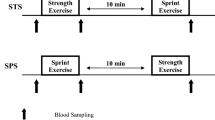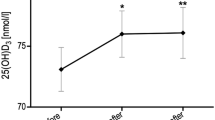Abstract
The purpose of the present study was to examine the growth hormone (GH) response to treadmill sprinting in male (M) and female (F) sprint- and endurance-trained atheletes. A group of 11 sprint-trained (ST; 6M, 5F) and 12 endurance-trained (ET; 6M, 6F) athletes performed a maximal 30-s sprint on a nonmotorized treadmill. Peak power and mean power expressed in watts or in watts per kilogram body mass were higher in ST than in ET (P < 0.01) and in the men compared to the women (P < 0.01). Serum GH was greater in ST than in ET athletes, but was not statistically significantly different between the men and the women [mean peak GH: ST 72.4 (SEM 12.5) compared to ET 26.3 (SEM 4.9) mU · I−1, P < 0.01; men 59.8 (SEM 13.3) compared to the women 35.8 (SEM 7.4) mU · l−1, n.s.]. Plasma ammonia and blood lactate concentrations were higher and blood pH lower during 1 h of recovery after the sprint in ST compared to ET (all P < 0.01). Multiple log linear regression showed that 82% of the variation in the serum peak GH response was explained by the peak power output and peak blood lactate response to the sprint. As serum GH was still approximately ten times the basal value in ST athletes after 1 h of recovery, it is suggested that the exercise-induced increase in GH could have important physiological effects in this group of athletes, including increased protein synthesis and sparing of protein degradation leading to maintained or increased muscle mass.
Similar content being viewed by others
References
Al-damluji S (1993) Adrenergic control of the secretion of anterior pituitary hormones. Baillieres Clin Endocrinol Metab 7:355–392
Bloom SR, Johnson RH, Park DM, Rennie MJ, Sulaiman WR (1976) Differences in the metabolic and hormonal response to exercise between racing cyclists and untrained individuals. J Physiol 258:1–18
Boden G, Soeldner JS (1967) A sensitive double antibody RIA for human growth hormone. Diabetologia 3:413–421
Bonen A, Haynes FW, Graham TE (1991) Substrate and hormonal responses to exercise in women using oral contraceptives. J Appl Physiol 70:1917–1927
Brooks S, Cheetham ME, Williams C (1985) Endurance-training and the catecholamine response to maximal exercise. J Physiol 361:81P
Bunt JC, Boileau RA, Bahr JM, Nelson RA (1986) Sex and training differences in human growth hormone levels during prolonged exercise. J Appl Physiol 61:1796–1801
Cheetham ME, Williams C, Lakomy HKA (1985) A laboratory running test: metabolic responses of spring and endurance-trained athletes. Br J Sports Med 81–84
Cheetham ME, Boobis LH, Brooks S, Williams C (1986) Human muscle metabolism during treadmill sprinting. J Appl Physiol 61:54–60
Costill DL, Daniels J, Evans W, Fink W, Krahenbuhl G, Saltin B (1976) Skeletal muscle enzymes and fibre composition in male and female track athletes, J Appl Physiol 40:149–154
Cuneo RC, Salomon F, Wiles M, Hesp R, Sonksen PH (1991) Growth hormone treatment in growth hormone-deficient adults, II. Effects on exercise performance. J Appl Physiol 70:695–700
Davis TME, Burrin JM, Bloom SR (1987) Growth hormone (GH) release in response to GH-releasing hormone in man is 3-fold enhanced by galanin. J Clin Endocrinol Metab 65:1248–1252
Dieguez C, Page MD, Scanlon MF (1988) Growth hormone neuroregulation and its alterations in disease states. Clin Endocrinol (Oxf) 28:109–143
Dill DB, Costill DL (1974) Calculation of percentage changes in volumes of blood, plasma and red cells in dehydration, J Appl Physiol 37:247–248
Fish HR, Chernow B, O'Brian JT (1986) Endocrine and neurophysiologic responses of the pituitary to insulin-induced hypoglycaemia: a review. Metabolism 35:763–780
Fong Y, Rosenbaum M, Tracey KJ, Raman G, Hesse DG, Matthews DE, Leibel RL, Gertner JM, Fischman DA, Lowry SF (1989) Recombinant growth hormone enhances muscle myosin heavy-chain mRNA accumulation and amino acid accrual in humans, Proc Natl Acad Sci USA 86:3371–3374
Greenhaff PL, Nevill ME, Soderlund K, Bodin K, Boobis LH, Williams C, Hultman E (1994) The metabolic responses of human type I and II muscle fibres during maximal treadmill sprinting. J Physiol 478:149–155
Kindermann W, Schnabel A, Schmitt WM, Biro G; Cassens J, Weber F (1982) Catecholamines, growth hormone, cortisol, insulin and sex hormones in anaerobic and aerobic exercise. Eur J Appl Physiol 49:389–399
Kozlowski SJ, Chwalbinska-Moeta M, Vigas K, Kaciuba-Vscilko H, Nazar K (1983). Greater serum growth hormone response to arm than leg exercise performed at equivalent oxygen uptake. Eur J Appl Physiol 52:131–135
Lakomy HKA (1987) The use of a non-motorised treadmill for analysing sprint performance, Ergonomics 30:627–637
Maughan RJ (1982) A simple and rapid method for the determination of glucose, lactate, pyruvate, alanine, 3-hydroxybutyrate and acetoacetate on a single 20 μl blood sample. Clin Chim Acta 122:231–240
Nevill ME, Boobis LH, Brooks S, Williams C (1989) Effect of training on muscle metabolism during treadmill sprinting in man. J Appl Physiol 67:2376–2382
Seth J, Brown LM (1988) A simple RIA for cortisol. Clin Chim Acta 86:109–120
Shirreffs SM, Maughan RJ (1994) The effect of posture change on blood volume, serum potassium and whole body electrical impedance. Eur J Appl Physiol 69:461–463
Sidney KH, Shephard RJ, Webster B, Wood DE (1974) Hormonal responses to exercise-effects of age, sex and endurance-training. Physiol Rev 49:818
Soeldner J, Slone D (1965) Critical variables in the radio-immunoassay of serum insulin using the double antibody technique, Diabetes 14:771–779
Sutton JR, Jones NL, Toews CJ (1976) Growth hormone secretion and acid-base iteration at rest and during exercise, Clin Sci Mol Med 50:241–247
Van Helder WP, Radomski MW, Goode RC (1984) Growth hormone responses during intermittent weight lifting exercise in men, Eur J Appl Physiol 53:31–34
Van Helder WP, Casey K, Radomski MW (1987) Regulation of growth hormone during exercise by oxygen demand and availability. Eur J Appl Physiol 56:628–632
Vigas MS, Nemeth S, Jurcoricora L, Mikula J, Komadel L (1974) The importance of lactate in exercise-induced growth hormone release in man, Radioimmunoassays: methodology and applications in physiology and clinical studies. Horm Metab Res [Suppl] 5:166–169
Winder WW, Hickson RC, Hagberg JM, Ehsani AA, McLane JA (1979) Training-induced changes in hormonal and metabolic responses to submaximal exercise, J Appl Physiol 46:766–771
Yan Z, Biggs RB, Booth FW (1993) Insulin-like growth factor immunoreactivity increases in muscle after acute ecentric contractions. J Appl Physiol 74:410–414
Author information
Authors and Affiliations
Additional information
This work was completed at Department of Physical Education, Sports Science and Recreation Management, Loughborough University
Rights and permissions
About this article
Cite this article
Nevill, M., Holmyard, D.J., Hall, G.M. et al. Growth hormone responses to treadmill sprinting in sprint- and endurance-trained athletes. Eur J Appl Physiol 72, 460–467 (1996). https://doi.org/10.1007/BF00242276
Accepted:
Issue Date:
DOI: https://doi.org/10.1007/BF00242276




